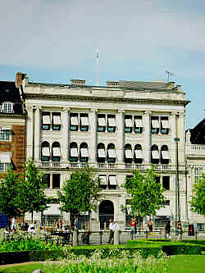User:Milton Beychok/Sandbox: Difference between revisions
imported>Milton Beychok No edit summary |
imported>Milton Beychok |
||
| Line 17: | Line 17: | ||
==Governance and organization== | ==Governance and organization== | ||
The EEA is governed by a '''Management Board''' and a '''Bureau''', with a '''Scientific Committee''' in an advisory capacity. | The EEA is governed by a '''Management Board''' and a '''Bureau''', with a '''Scientific Committee''' in an advisory capacity.<ref>[http://www.eea.europa.eu/about-us/governance/management-board/presentation The Management Board]</ref><ref>[http://www.eea.europa.eu/about-us/governance/management-board/mb-rules-procedure.pdf Management Board Rules of Procedure (RoP)]</ref> | ||
<ref>[http://www.eea.europa.eu/about-us/governance/scientific-committee Scientific Committee]</ref> | |||
===Management Board=== | ===Management Board=== | ||
The | The Board is the decision making body of the EEA. The Board decisions include: adoption of annual and multi-annual work programs, annual reports and other strategic documents, approval of the EEA’s budget, appointment of an EEA Executive Director and an accounting officer, election of a board chairperson and vice-chairpersons, and designation of Scientific Committee members. | ||
The | The Board consists of representatives of the 32 EEA member countries, two representatives of the European Commission and two representatives designated by the European Parliament. Each member of the board may be represented by an alternate member. The Board members are all high-level official within their nation's environmental ministries. | ||
The | The Board chairperson and four vice-chairpersons are elected from amongst the Board members for a term of three years. The Board normally meets three times a year.<ref>[http://www.eea.europa.eu/about-us/governance/management-board/meetings Meetings]</ref> | ||
===Bureau=== | ===Bureau=== | ||
The Bureau is composed of the Board chairperson, up to five Board vice-chairpersons, one European Commission representative and one of the members designated by the European Parliament. The Bureau is entitled to take executive decisions, necessary for the effective operation of the EEA in between meetings of the Management Board. | |||
==Scientific Committee== | |||
The Scientific Committee advises the Management Board and the Executive Director. It has three major tasks: | The Scientific Committee advises the Management Board and the Executive Director. It has three major tasks: | ||
To deliver an opinion on the EEA multi-annual and annual work-programmes | |||
To | *To deliver an opinion on the EEA multi-annual and annual work-programmes. | ||
To provide advice and/or opinion on any scientific matter concerning the | *To provide advice to the Executive Director regarding recruitment of the EEA's scientific staff. | ||
*To provide advice and/or opinion on any scientific matter concerning the EEA's activity, which the Management Board or the Executive Director may submit to it. | |||
The Committee members are independent scientists from the EEA member-countries, covering a variety of environmental fields related to the EEA's activities. The Committee membership shall not exceed 20 experts. The members are chosen through an open selection process and appointed for a four-years term, renewable once. | |||
==European Topic Centre on Air and Climate Change== | ==European Topic Centre on Air and Climate Change== | ||
Revision as of 16:48, 1 October 2008
The European Environment Agency (EEA) is an agency of the European Union (EU) established to function as a major source of information and data to be used in developing, adopting, implementing and evaluating environmental policy by its member European countries.[1]
The EEA was established by Regulation 1210/90 adopted in 1990 by the European Economic Community (EEC),[2] which subsequently became a part of the EU in 1993. The EEA became operational in 1994 and it is currently headquartered in Copenhagen, Denmark with 172 staff members.[3]
The same EEC Regulation 1210/90 that established the EEA also established the European Environmental Information and Observation Network (EIONET) and the EEA is charged with coordinating with the EIONET.[4]
As of 2008, the EEA has 32 member countries and six cooperating countries. The 32 member countries include the 27 member states of the European Union together with Iceland, Liechtenstein, Norway, Switzerland and Turkey. The six cooperating countries are West Balkan countries: Albania, Bosnia and Herzegovina, Croatia, Republic of Macedonia, Montenegro and Serbia.
The primary clients of the EEA are the member countries of the EU as well as the major institutions of the EU: the European Commission, the European Parliament and the Council of the European Union. In addition to this central group of EU policy makers, the EEA serves other EU institutions such as the European Economic and Social Committee and the Committee of the Regions.
The EEA does not initiate or implement any air quality or other environmental standards or emission ceiling limits. That is done by the European Commission, specifically by their Commissioner of the Environment and Environment-Directorate General.[5][6][7][8]
Governance and organization
The EEA is governed by a Management Board and a Bureau, with a Scientific Committee in an advisory capacity.[9][10] [11]
Management Board
The Board is the decision making body of the EEA. The Board decisions include: adoption of annual and multi-annual work programs, annual reports and other strategic documents, approval of the EEA’s budget, appointment of an EEA Executive Director and an accounting officer, election of a board chairperson and vice-chairpersons, and designation of Scientific Committee members.
The Board consists of representatives of the 32 EEA member countries, two representatives of the European Commission and two representatives designated by the European Parliament. Each member of the board may be represented by an alternate member. The Board members are all high-level official within their nation's environmental ministries.
The Board chairperson and four vice-chairpersons are elected from amongst the Board members for a term of three years. The Board normally meets three times a year.[12]
Bureau
The Bureau is composed of the Board chairperson, up to five Board vice-chairpersons, one European Commission representative and one of the members designated by the European Parliament. The Bureau is entitled to take executive decisions, necessary for the effective operation of the EEA in between meetings of the Management Board.
Scientific Committee
The Scientific Committee advises the Management Board and the Executive Director. It has three major tasks:
- To deliver an opinion on the EEA multi-annual and annual work-programmes.
- To provide advice to the Executive Director regarding recruitment of the EEA's scientific staff.
- To provide advice and/or opinion on any scientific matter concerning the EEA's activity, which the Management Board or the Executive Director may submit to it.
The Committee members are independent scientists from the EEA member-countries, covering a variety of environmental fields related to the EEA's activities. The Committee membership shall not exceed 20 experts. The members are chosen through an open selection process and appointed for a four-years term, renewable once.
European Topic Centre on Air and Climate Change
The European Topic Centre on Air and Climate Change (ETC/ACC) assists the European Environment Agency (EEA) in its support of European Union (EU) policy in the field of air pollution and climate change.[13] It is a consortium of 14 European institutions, established in 2001 by the EEA, with an annual budget of about 2 millions Euros, with RIVM-MNP as the lead institution. In March 2004 the EEA extended the contract with the consortium through 2006.
The ETC/ACC reports on the progress of EU environmental policy on air pollutant emissions,[14] air quality, and climate change issues. The ETC/ACC participates in relevant reports issued by the EEA, collects data concerning the current state of the environment, and harmonises European air quality monitoring networks and reporting obligations.
The ETC/ACC also maintains an online copy of the Model Documentation System (MDS)[15] which is a catalogue of most of the air quality and air pollution dispersion models developed and/or used in Europe. The MDS catalogue listings include the name, description and support contacts for each model as well as other pertinent technical details. The MDS was developed at the Aristotle University in Thessaloniki, Greece, by Prof. Nicolas Moussiopoulos.
European Topic Centre on Land Use and Spatial Information
The European Topic Centre Land Use and Spatial Information (ETC-LUSI)[16] is an international consortium under contract to the European Environment Agency (EEA). The consortium is led by the Autonomous University of Barcelona (UAB) from Spain.
ETC-LUSI is part of the European Environmental Information and Observation Network (EIONET)[4] and a support to other Eionet partners. The activities have an important component on networking with various experts in the member countries on data harmonisation, quality issues and exchange of data. ETC-LUSI assists countries in discussing options for improving national information systems related to the topic of land use and spatial information.
References
- ↑ The European Environmental Agency (EEA) website
- ↑ EEC Regulation 1210/90
- ↑ EEA Organizational Chart
- ↑ 4.0 4.1 Environmental Information and Observation Network (EIONET)
- ↑ The Commisioner of the Environment
- ↑ The Environment Directorate General
- ↑ Air Quality Standards
- ↑ National Emission Ceiling (NEC) Directives
- ↑ The Management Board
- ↑ Management Board Rules of Procedure (RoP)
- ↑ Scientific Committee
- ↑ Meetings
- ↑ European Topic Centre on Air and Climate Change (ETC/ACC)
- ↑ EMEP/CORINAIR Emission Inventory Guidebook - 2006
- ↑ MDS - Model Documentation System
- ↑ European Topic Centre Land Use and Spatial Information (ETC-LUSI)
External links
- European Environment Agency website
- European Topic Centre on Land Use and Spatial Information (ETC LUSI)
- European Topic Centre on Air and Climate Change(ETC/ACC)
- Model Documentation System (MDS)
- The European Environment Agency's near real-time ozone map (ozoneweb)
- EnviroWindows.
See also

